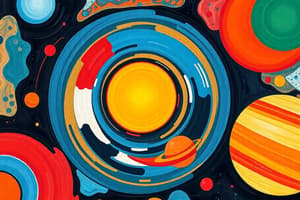Podcast
Questions and Answers
Güneş Sistemi yaklaşık kaç milyar yıl önce oluştu?
Güneş Sistemi yaklaşık kaç milyar yıl önce oluştu?
- 3.6 milyar yıl
- 4.6 milyar yıl (correct)
- 5.6 milyar yıl
- 6.6 milyar yıl
En soğuk gezegen hangisidir?
En soğuk gezegen hangisidir?
- Neptün (correct)
- Venus
- Mars
- Jüpiter
Güneş Sistemi'nin merkez noktasında hangi gök cismi bulunur?
Güneş Sistemi'nin merkez noktasında hangi gök cismi bulunur?
- Güneş (correct)
- Satürn
- Jüpiter
- Mars
Dwarf gezegenlerden biri olan Plüton'un hangi kategoride sınıflandırıldığını biliyor musunuz?
Dwarf gezegenlerden biri olan Plüton'un hangi kategoride sınıflandırıldığını biliyor musunuz?
Asteroid kuşağı hangi gezegenler arasında bulunur?
Asteroid kuşağı hangi gezegenler arasında bulunur?
Flashcards are hidden until you start studying
Study Notes
Solar System
Overview
- The Solar System consists of eight planets, dwarf planets, asteroids, comets, and other objects orbiting around the Sun
- Formed approximately 4.6 billion years ago from a giant cloud of gas and dust called the solar nebula
Planets
- Terrestrial Planets:
- Mercury: smallest planet, closest to the Sun
- Mars: known for its reddish appearance, potential for life
- Earth: third planet from the Sun, home to diverse life forms
- Venus: hottest planet, thick atmosphere traps heat
- Gas Giants:
- Jupiter: largest planet, massive storms, and numerous moons
- Saturn: known for its prominent ring system, many moons
- Ice Giants:
- Uranus: tilted axis, resulting in extreme seasons
- Neptune: farthest planet from the Sun, strong winds
Other Objects
- Dwarf Planets:
- Pluto: previously considered a planet, now classified as a dwarf planet
- Eris: similar in size to Pluto, highly eccentric orbit
- Asteroids:
- Small, rocky objects, mostly found in the asteroid belt between Mars and Jupiter
- Can be remnants of planets that never formed
- Comets:
- Icy bodies, release gas and dust as they approach the Sun
- Originated from the outer Solar System, often with highly elliptical orbits
Sun's Role
- The Sun is the center of the Solar System, providing light and heat to the planets
- Its gravity holds the planets in their orbits, shaping the Solar System's structure
Güneş Sistemi
Genel Bakış
- Güneş Sistemi, sekiz gezegen, cüce gezegenler, asteroidler, kuyruklu yıldızlar ve diğer objelerin güneş etrafında dönmesiyle oluşur
- Yaklaşık 4.6 milyar yıl önce, bir dev gaz ve toz bulutu olan güneş nebülalarından oluşmuştur
Gezegenler
- Kayaç Gezegenleri:
- Merkür: Güneş'e en yakın, en küçük gezegen
- Mars: kızıl görünümü ve yaşam olasılığı ile bilinir
- Dünya: Güneş'ten üçüncü gezegen, çeşitli yaşam formlarına ev sahipliği yapar
- Venüs: en sıcak gezegen, ısıyla kilitlenmiş kalın atmosferi bulunur
- Gaz Devleri:
- Jüpiter: en büyük gezegen, büyük fırtınalar ve birçok uydu
- Satürn: belirgin halka sistemi ve birçok uydu ile bilinir
- Buz Devleri:
- Uranüs: ekseninin eğimi, aşırı mevsimlere neden olur
- Neptün: Güneş'ten en uzak gezegen, güçlü rüzgarları bulunur
Diğer Objeler
- Cüce Gezegenler:
- Plüton: önceden bir gezegen olarak görülür, şimdi cüce gezegen olarak sınıflandırılır
- Eris: Plüton'a benzer büyüklükte, yüksek eltiktik yörüngeye sahiptir
- Asteroidler:
- Küçük, kayaç objeler, çoğu Mars ve Jüpiter arasında asteroid kuşağında bulunur
- Oluşmamış gezegenlerin kalıntıları olabilir
- Kuyruklu Yıldızlar:
- Buzlu cisimler, Güneş'e yaklaştıkça gaz ve toz yayarlar
- Dış Güneş Sistemi'nden gelir, genellikle yüksek eksantrik yörüngeye sahiptir
Güneş'in Rolü
- Güneş, Güneş Sistemi'nin merkezi, gezegenlere ışık ve ısı sağlar
- Kütleçekim gücü, gezegenleri yörüngelerinde tutar, Güneş Sistemi'nin yapısını şekillendirir
Studying That Suits You
Use AI to generate personalized quizzes and flashcards to suit your learning preferences.




